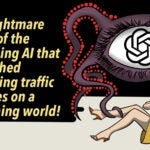 This year’s Dmexco conference in Cologne, Germany, has drawn roughly 26,000 attendees, vendors and other visitors.
This year’s Dmexco conference in Cologne, Germany, has drawn roughly 26,000 attendees, vendors and other visitors.
Yesterday they streamed into the standing-room-only Congress Hall to listen to a panel with Criteo President Greg Coleman, Aegis Media Americas CEO Nigel Morris and Google’s managing director of media platforms for northern and central Europe, Damian Lawlor. Rounding out the discussion were Frederic Joseph, Performics CEO of the EMEA region; Nicolle Pangis, president of the Real Media Group; and David Yovanno, president of Mediaplex.
The panel was moderated by Quentin George, co-founder and principal of the programmatic consulting firm Unbound. George got the discussion going with a classic marketing question that included a twist: “Let’s say the seven of us have started a new company and you’ve each been given 50 million euros to spend on launching a product.”
What do you spend it on? And, he added, “How has the answer to that question changed in the last five years?”
According to Morris, “We can be much more accurate about understanding who our consumer is. As long as we’re clear about the kind of person we’re looking for, we can be much more proactive in understanding who they are and what they do … and be much more multipurposed about reaching them in the right environment at the right time.”
Joseph noted, “If you had asked me that question a few years ago, I would have probably been able to spend the entire budget on search and be successful. Today things have changed dramatically.”
While search and affiliate marketing are “great places to start,” Joseph continued, there “tends to be a limit to the amount of scale that you can drive through those types of channels. And so you’ve got to start looking at other places.”
Pangis argued that marketers have fallen short in combining technology with creative and forgotten “that there’s room for both.” Using TV advertising as an example, “the beauty of digital,” according to Pangis, is “different from television where you can get a tremendous amount of scale, but the measurement of effectiveness might not be there. With digital you can get that measurement but we forgot what creativity can bring to digital. We already have the scale, now we need to talk about the story.”
George also asked the following question: “Which companies in the ecosystem are not adding value and should just get out of the way?”
After teasing George by asking, “Do you want us to name those companies?” Coleman’s response was that, “every marketer needs to be able to establish a screening device on how to evaluate those companies. The noise in the marketplace … is so deafening and horrible. Everyone’s No. 1. What I have been advocating is that every company needs to develop a scalable, testing infrastructure to cull out what seems to be the best and brightest and to test them to see what works.”
Yovanno turned the spotlight on a specific industry. “If you’re pressing for categories, I’ll throw one out there: tag management,” he said. “They need to diversify into other things like attribution and data-management services. Brands are taking risks with some of these companies … that may not be around a year from now.”
Lawlor focused on the idea of growth in unified platforms. “As more companies come up in the Lumascape,” he commented, “they’re either going to provide a service that has clear value and get IPO’d or the value’s going to go away or they’ll get acquired. The overall concept of a unified platform, with people innovating inside of it, is the future.”
Pangis offered this observation: “I think the point solution will become pieces of the platform and the Lumascape will turn into a few players that are platforms and point providers that plug into the platforms. There’ll be different ways of implementation. One would be the way Google’s doing it with their proprietary approach and others will have a mix of proprietary solutions and partnerships.”
George concluded the panel by asking, “What is the first thing you need to stop doing as an industry, and what do you think are the biggest opportunities in advertising?”
The largest opportunity for the advertiser, according to Joseph, is to “crack attribution across channels and devices.” Google has made “a big leap but no one has cracked it yet,” Joseph said. In terms of what people in the ad industry should stop doing, networks that “don’t offer entry [to the various channels] will be in a difficult situation in the next few years.”
Pangis argued that, “the combination of creative and technology is going to be of increasing importance over the next 12 to 24 months.” She also noted that advertisers need to stop chasing after the latest trend or gadget. “That’s what’s creating the noise,” Pangis said. “There’s a PowerPoint deck and suddenly there’s a technology behind it.”
Coleman focused on attribution without offering an area that advertisers need to move away from. “We’re still in the early stages of understanding full attribution, but unless you have that compass pointed in the right direction, you can make a lot of bad decisions,” Coleman said.
Lawlor noted that brands need to work on promoting user engagement and “getting out of our own way in terms of the inefficiency that’s out there. We need to stop thinking in terms of features and products,” he said. “We still have marketers and agencies and other groups that have separate search and display divisions when people need to work together.”
Yovanno commented that companies “need to stop spending millions of dollars” without knowing if it will lead to sales. In terms of where the most opportunities lie in advertising, Yovanno pointed to personalization and scale. “Some of the challenges that Firefox and iOS are threatening … mean there are some privacy things as an industry that have to be figured out,” Yovanno said. “But I’m very optimistic that our industry will be able to maintain a very deep profile on people over a persistent length of time — a few months is a benchmark for us — and being able to identify them on multiple devices.”













